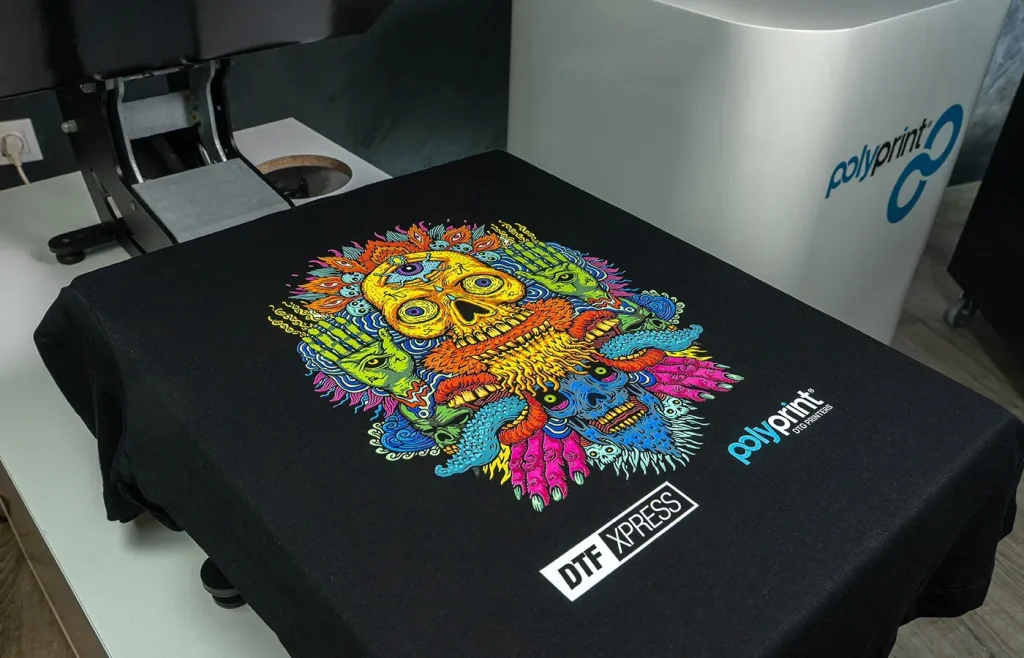DTF printing, or Direct to Film printing, has revolutionized the world of custom apparel and merchandising by offering an innovative alternative to traditional printing methods such as screen printing. This exciting technology allows for exceptional quality and vibrant colors, appealing to businesses and consumers aiming for eye-catching designs. As the demand for personalization in prints rises, DTF vs traditional printing methods have become a prominent topic of discussion among creators. DTF technology stands out by minimizing setup costs and enabling quick production speeds, making it an attractive option for small to medium-sized enterprises. In this article, we’ll compare these methods in terms of quality, cost-effectiveness, versatility, and environmental impact to help you make the best choice for your printing needs.
When considering various printing technologies, options like DTF or Direct to Film printing stand at the forefront. This method employs a unique approach, applying high-definition images directly onto a specialized film before transferring them to fabrics. Conversely, traditional techniques, including screen printing, have been relied upon for years, providing time-tested solutions for various printing challenges. As we explore the differences between these two distinct processes, terms like print quality, production speed, and cost-effectiveness will be essential in guiding our discussion. Understanding the nuances of these printing alternatives is crucial for anyone involved in the creative industries.
Understanding DTF Printing Technology and Its Advantages
DTF printing technology, or Direct to Film printing, is revolutionizing the way companies approach customized printing. This method utilizes a unique process where designs are printed onto a special film, before being transferred onto various fabric substrates. One of the key advantages of DTF is its ability to produce vibrant colors and detailed graphics, making it particularly well-suited for intricate designs and artwork that require a high level of fidelity. Additionally, DTF printing accommodates a variety of materials, from cotton to synthetic blends, allowing for a broad application across different industries.
Beyond the vibrant outputs, DTF printing is celebrated for its cost-effectiveness, especially for small to medium production runs. Unlike traditional methods that require extensive setups and registration costs, DTF allows for quick turnarounds with minimal setup, appealing to small business owners and startups looking to keep overhead low. This seamless integration of technology and creativity empowers entrepreneurs to explore diverse product lines without the fear of large inventory costs.
Comparing DTF Printing With Traditional Printing Methods
When comparing DTF with traditional printing methods, such as screen printing, several factors come into play. Screen printing has been the go-to method for many years, known for its durability and ability to handle large volumes efficiently. However, it often falls short when it comes to detailed designs and color gradation. In contrast, DTF technology shines in producing high-quality prints that maintain their integrity on dark fabrics, something that traditional screen printing struggles with. This comparison highlights the progressive shift in the printing landscape as DTF provides a competitive edge for those seeking both quality and adaptability.
Moreover, the debate of DTF vs traditional printing often revolves around setup times and flexibility. Screen printing is typically optimal for large orders due to economies of scale, while DTF printing allows for flexibility in lower quantities alongside quick modifications to designs without excessive cost implications. This makes DTF an appealing choice for personalized items and fashion retail, where changes can be made on the fly.
Cost-Effectiveness: DTF vs Traditional Printing
Cost is a crucial factor when choosing between DTF and traditional printing methods. DTF printing is often more affordable for small runs due to its lower initial investment and operational costs. Unlike traditional screen printing, which involves costly screens and setup fees, DTF utilizes a more streamlined and digital approach that helps keep expenses down. This is particularly beneficial for small businesses that may not have the capital to invest heavily upfront.
On the other hand, traditional printing may offer significant savings when dealing with larger bulk orders. The costs per unit decrease as the volume increases, making traditional methods suitable for large-scale productions. However, businesses must weigh the benefits of lower initial costs of DTF against the long-term savings potential of screen printing when determining which method best suits their production needs.
Production Speed: The Competitive Edge of DTF Printing
In a fast-paced market, production speed can significantly influence success. DTF printing stands out due to its quick turnaround capabilities, allowing for on-demand printing without sacrificing quality. The ability to print directly onto the film minimizes downtime between prints, making DTF an attractive option for businesses aiming to respond swiftly to market demands and customer requests.
Conversely, although traditional printing methods like screen printing can achieve quick outputs after the initial setup, the time taken for each setup can hinder flexibility for smaller print runs. For businesses requiring rapid prototyping or tailored designs, DTF provides the agility needed in today’s competitive environment, making it a modern alternative to more conventional methods.
Versatility in Applications: DTF and Traditional Printing
Versatility is a significant advantage when choosing a printing method. DTF printing excels with its compatibility across various fabrics, including cotton and polyester blends, making it suitable for a diverse range of projects. This adaptability does not only extend to apparel but also to other products like bags and home textiles, showcasing DTF’s application potential across different sectors.
On the other hand, traditional printing methods face limitations based on fabric type. While screen printing works well on select materials, it can struggle with blends and intricate designs as compared to DTF printing. Thus, understanding the fabric requirements of the intended application can guide businesses and creators in selecting the right printing method to achieve their desired results.
Environmental Considerations: DTF vs Traditional Printing Methods
As sustainability becomes increasingly important to consumers, the environmental impact of printing methods is a relevant consideration. DTF printing utilizes water-based inks, which are generally less harmful to the environment compared to traditional plastisol inks commonly used in screen printing. This eco-friendliness aligns with growing consumer preferences for sustainable solutions, positioning DTF as a more environmentally responsible choice within the printing landscape.
However, it is essential to note that the environmental impact of traditional printing can be mitigated through the use of innovative inks. Many companies are now adopting bio-based or water-based inks, which can reduce the carbon footprint of screen printing. Thus, both methods have potential pathways towards sustainability, and selecting the right approach will depend on individual business practices and environmental commitments.
Frequently Asked Questions
What is DTF printing and how does it differ from traditional printing methods?
DTF printing, or Direct to Film printing, is a modern technique that transfers designs onto film before applying them to fabrics. Unlike traditional printing methods like screen printing, DTF allows for vibrant, detailed prints on various materials, including dark fabrics. The key difference lies in the process; DTF uses a digital approach which is generally faster and more versatile compared to the setup-intensive nature of traditional printing.
Is DTF printing more cost-effective than traditional screen printing?
Yes, DTF printing is often more cost-effective for small to medium print runs. It eliminates many setup fees required for traditional screen printing and leverages digital technology to reduce material costs. However, for large quantities, traditional screen printing might still be more economical due to lower per-unit costs as the volume increases.
What are the quality advantages of DTF printing over traditional printing methods?
DTF printing offers superior quality due to its ability to print intricate designs with vibrant colors. It utilizes white ink for high contrast on dark fabrics, providing a softer feel and better integration with fabric compared to traditional methods like screen printing, which may struggle with complex color gradients.
Can DTF printing be used on a variety of fabrics compared to traditional printing?
Absolutely! DTF printing is compatible with a wide range of fabrics, including cotton, polyester, and blends, making it more versatile than traditional printing methods, which typically perform better on specific fabric types and may not work well with synthetic blends.
What is the environmental impact of DTF printing compared to traditional printing methods?
DTF printing generally has a lower environmental impact, as it frequently utilizes water-based inks, reducing toxicity compared to traditional plastisol inks used in screen printing. However, DTF printing does generate waste film, necessitating responsible disposal methods. Environmental impacts can vary greatly depending on the inks used in traditional printing.
Why might businesses prefer DTF printing over traditional printing methods for custom designs?
Businesses may prefer DTF printing for custom designs due to its quick turnaround times, ability to produce high-quality, vibrant prints on-demand, and cost-effectiveness for small runs. Traditional printing methods, while reliable, often require longer setup times and are better suited for larger orders.
| Aspect | DTF Printing | Traditional Printing (Screen Printing) |
|---|---|---|
| Quality and Detail | Exceptional vibrancy and detail, ideal for intricate designs with white ink capability. | Durable and consistent; however, less vibrant for complex designs. |
| Cost-effectiveness | Lower cost of entry for small to medium runs; reduces setup fees. | More cost-efficient for large volumes; setup costs decrease with more units produced. |
| Production Speed | Faster production with quick turnarounds, minimal downtime. | Longer setup time; efficient for large quantities once setup is complete. |
| Versatility | Compatible with various materials and products, like bags or home textiles. | Limited to specific fabric types; best suited for suitable fabrics. |
| Environmental Impact | Uses water-based inks, generally less harmful; waste film must be managed. | Impact varies; advancements in sustainable inks are being made. |
Summary
DTF printing has revolutionized the printing industry by offering a unique combination of vibrant image quality, rapid production speeds, and versatility across various fabric types. This modern printing technique stands out for its ability to create detailed prints while accommodating smaller and custom orders, catering to a wide range of applications from apparel to accessories. As the market continues to embrace DTF printing, it contrasts with traditional methods by emphasizing eco-friendly practices and cost savings for small businesses. Understanding the benefits of DTF printing can enhance your decision-making when selecting a printing method that not only meets production demands but also aligns with your aesthetic vision.



